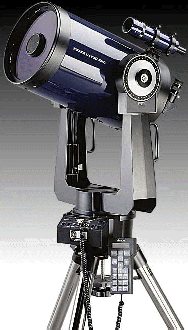


Welcome to the Revolution!!!
Personal astronomy has taken a giant leap forward
in last few years. With the advent of affordable, computerized telescopes,
astronomical CCD cameras, sky and image processing software, and digitized
sky on CD Rom; the world of astronomy has opened up to a universe of possibilities.
Individuals can now accomplish what was once only possible with only a
few of the largest observatories in the world.
The computerization of the telescope, combined with
detailed accurate software, has eliminated much sky hopping, and sky chart
navigating. A celestial object can be accurately located within seconds.
When it comes to light gathering abilities, the CCD
camera makes up in sensitivity and time, what much larger telescopes had
in size. Of course now, these observatories are using CCD cameras as well.
To our benefit--the power of the internet, has been unleashed. We can link
up to these sites. We too can see what has never been seen before. Image
processing software can unblur an image, bring out the faintest details,
and even eliminate most light pollution. It is even possible to image deep
sky objects on full moon nights!
The introduction of RealSky CDROM , (a set of 9 CD
ROMS of complete images of the sky in the Northern Hemisphere down to -15
degrees), has made it available to bring actual images of the sky onto
a computer screen. These images can be compared with the image just taken
by the CCD camera. Asteroids can be hunted down, supernova found, and comets
discovered.
"The Telescope"
The Meade 12" LX 200 F/10 is
the workhorse of our observatory. I use it with an Optec .33 Focal Reducer,
which maximizes the telescope's CCD capabilities at F/3.3. It has
always been reliable, and with it's GOTO capabilities, it always put the
image on our CCD chip. The telescope is remotely controlled and
permanently polar mounted. Which makes it a great small observatory scope.
The only limiting factor is that with accesories attached, I keep
away from the polar area, as the camera will not swing thru the fork mount
and will hit the telescope. This can damage the Dec drive & or the
camera. If used in Alt/Az mode you would have the same problem, near the
sky zenith. Overall, it's a great telescope.
Meade
LX200 Technical Info
Smart
Drive Info
C-Sat
Satellite Tracking Software for LX200
Doc
G's Info Site
Handicapper
Modifications for the LX200
LX200
Modifications & Tools
LX200
API Software-beta
LX-200
Astronomer's Control Panel
MAPUG
Archives
MAPUG
Topical Archive by Stewart
Meade
Star database for Use in TheSky Astronomy Software
Milburn
wedge
Observing
List for LX200
Schmidt-Cassegrain
Mirror Stablizer
SBSat:
Satellite Tracking and Remote Control LX200
Star
Cross-Reference Data For LX200 Users
Wje's
Astronomy Page for LX200
"The Camera"
Meade
Pictor 416 Technical Info.
Optec,
Inc. MAXfield FAQ Page
An
Idiot's Guide To Using The 416XT CCD Camera
"The Software"
TheSky
Level IV by Software Bisque
Meade
Epoch 2000sk
Meade
Epoch 2000ip
Paint
Shop Pro 4.0
GIF
Construction Set
RealSky
CD-ROM
Adobe Photoshop
Other Software
AstroArts
Home Page
Astronomical
Software & Documentation Service
Computer
Aided Astronomy
EzPhot
CCD Photometry Software
ftp://ftp.halcyon.com:/pub/users/burrjaw/
MaxImDL/CCD
MIRA
image processing Software
Tpoint
Software
WinZip
"CCD Tips & Techniques"
The Arcturus
Observatory Modified Hartman Mask --An improved focusing mask
for CCD imaging.
Quick CCD
Object Location Technique --A new technique to locate object
speedily with a CCD camera.
Other CCD Tip & Techniques
CCD
University
CCD
Polar Alignment
High
Resolution CCD Imaging
Image
Processing using Picture Window Program
The
Starlight Xpress CCD camera
Have a discovery?
IAU:
Central Bureau for Astronomical Telegrams
Guide
to Minor-Body Astrometry
Take me back to
Sitemap
What's
New
Table of
Contents